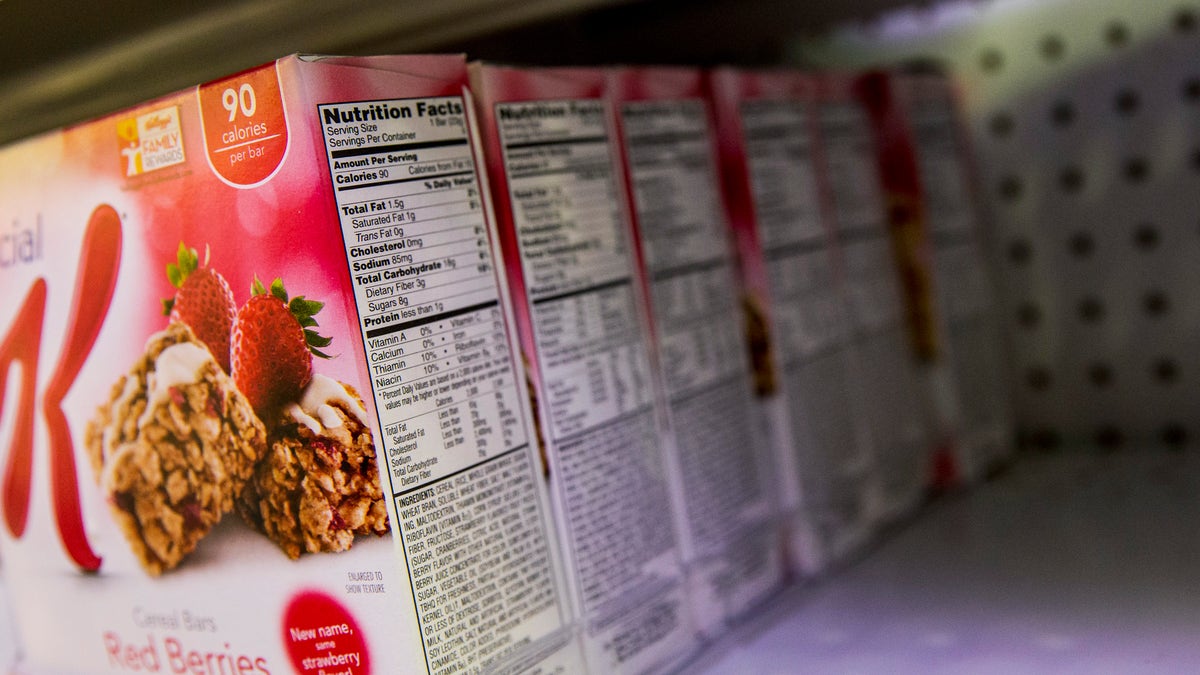
The Nutrition Facts label is seen on a box of Cereal Bars at a store in New York February 27, 2014. (REUTERS/Brendan McDermid)
Sugar-free. Natural. Multigrain. These are just a few of the words you’ve likely seen on food packaging – words often used by food manufacturers in the hopes that they will elicit health-minded consumers to buy more of the product.
But do these claims really mean certain foods are better for your body? Bonnie Taub-Dix, RDN, a New York-based nutrition influencer and author of Read It Before You Eat It, answers a few questions to help you separate health from hype on the food label.
Q: What are some of the top ways consumers are fooled when they look at a nutrition label?
Taub-Dix: "Consumers are drawn to flashy labels on the front of packages, but we don’t eat the packages, it’s what’s inside that counts! The word ‘free’ is looked upon as calorie-free, but ‘fat-free’ could mean high in sugar, and ‘sugar-free’ could contain more fat than you bargained for. ‘Free’ could be costly when it comes to tricky labels. ‘Natural’ is also an attention-grabber, but it doesn’t really have any definition at this point — it is believed to mean wholesome and healthy, but salt and sugar are ‘natural.’ ‘Multigrain’ means many grains — but they are not necessarily whole grains. Choose whole grains or whole wheat as the first ingredient on the ingredient list.”
Don’t be fooled! Here are the definitions for three words you often see on food packages:
Free: A food labeled “free” means that a product contains no amount of, or only trivial amounts of, one or more of these components: fat, saturated fat, cholesterol, sodium, sugars and calories. Calorie-free means fewer than 5 calories per serving. Sugar-free and fat-free means less than 0.5 grams per serving.
Natural: Look before you leap for products boasting that they are “natural.” The FDA has not yet set a definition for “natural.”
Multigrain: When a food is labeled "multigrain," it means that more than one type of grain was used in the product -- though none of them are necessarily whole grains. To make sure a product is whole grain, look at package labels. The first ingredient listed should contain the word “whole,” such as “whole wheat” or “whole oats.”
Q: What's most important for consumers to look for on the nutrition label?
Taub-Dix: “Check serving sizes! It’s not all about what you eat… sometimes it’s about how much you eat. Although calories are the hottest listed item on the food label, surveys show that most of us don’t even know what they are or how much they need. Choosing realistic portion sizes creates lessons for life for you and your family.”
Don’t be fooled! Refer to this healthy portion size guide:
Grains
1 serving of cereal = 1 cup = baseball (or your fist)
1 serving of cooked rice, pasta, or mashed potato = 1/2 cup = 2 golf balls
1 serving of rolls or small starch portions = 2/3 cup = tennis ball
1 serving of bread = 1 ounce = 1 slice
Fruits/Vegetables
1 serving of fruit or vegetables = 1 cup = baseball (or your fist)
1 serving of dried fruit or vegetables = 1/4 cup = golf ball
Dairy Products
1 serving of cheese = 1 ounce = 2 dice
1 serving of milk or yogurt = 1 cup = baseball (or your fist)
Beans/Nuts
1 serving of beans = 1/2 cup = 2 golf balls
1 serving of nuts = 1/4 cup = golf ball
1 serving of nut butter = 2 tablespoons = ping pong ball (or 2 poker
chips)
Meats/Fish/Poultry
1 serving of meat, fish or poultry = 3 ounces = deck of cards (or a checkbook)
Fats/Oils
1 serving of oil or butter = 1 tablespoon = poker chip (or your thumb tip)
Q: Any other tips for food shopping?
Taub-Dix: “Don’t leave your glasses at home! Ha! Smart food shopping doesn’t need to take any more time than it does to make poor choices. Develop a ‘healthy shopping list’ and food shopping could be a breeze!”
Don’t be fooled! Create a healthy shopping list:
Compile a master list and store it in your computer so that you can print out a copy and keep it on the countertop or under a magnet on the fridge. This will enable you to circle items as needed or as you remember them. This will also prevent impulsive buys that can be less healthy and also saves you time from reading each label since the core items on your list you have checked out in advance.
